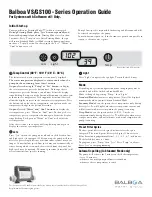
Due to our policy of continuous product innovation, some specifications may change without notification.
©
LG Electronics U.S.A., Inc., Englewood Cliffs, NJ. All rights reserved. “LG” is a registered trademark of LG Corp.
58 | duct (HIgH StatIc)
Ceiling-Concealed Duct (High Static) System Engineering Manual
reFrigerant PiPing deSign
refrigerant Piping System insulation
All refrigerant piping including field-provided isolation ball valves, service valves,
and elbows shall be completely insulated (up to the indoor unit piping connec-
tions) using closed cell pipe insulation. To prevent heat loss / heat gain through
the refrigerant piping, all refrigerant piping including liquid lines and vapor lines
shall be insulated separately. Any exposed piping may generate condensate or
will cause burns if touched. Insulation shall be a minimum 1/2″ thick, and thick
-
ness may need to be increased based on ambient conditions and local codes.
All insulation joints shall be glued with no air gaps. Insulation material shall fit
snugly against the refrigeration pipe with no air space between it and the pipe.
Insulation passing through pipe hangers, inside conduit, and/or sleeves must not
be compressed. Protect insulation inside hangers and supports with a second
layer. All pipe insulation exposed to the sun and outdoor elements shall be
properly protected with PVC, aluminum vapor barrier, or alternatively placed in a
weather-resistant enclosure such as a pipe rack with a top cover; and meet local
codes. Because Duct (High Static) indoor units are often installed in the ceiling
plenum, pay special attention to insulating the pipes.
The design engineer should perform calculations to determine if the factory-supplied insulation jackets are sufficient to meet local codes and
avoid sweating. Add additional insulation if necessary. Check the fit of the insulation jacket after the header fitting and all run-out pipes are
installed. Mark all pipes at the point where the insulation jacket ends. Remove the jacket. Install field provided insulation on the run-out and
main trunk pipes first. Install the LG-provided insulation plugs on the ends of all unused header ports. Peel the adhesive glue protector slip
from the insulation jacket and install the clam-shell jacket over the fitting.
Minimum Refrigerant Pipe Ethylene Propylene Diene Methylene (EPDM) Insulation Wall Thickness Requirements
Follow locals codes when selecting EPDM insulation wall thickness.
Table 39: Insulation Guidelines for Typical and Special Circumstances.
Classification
Air-conditioned location
Non-air conditioned location
1. Typical location
2. Special location
3. Typical location
4. Special location
Liquid pipe
ø1/4 inches
1/2 inches
1/2 inches
1/2 inches
1/2 inches
ø3/8 inches
≥ø1/2 inches
1/2 inches
1/2 inches
1/2 inches
1/2 inches
Vapor pipe
ø3/8 inches
1/2 inches
3/4 inches
3/4 inches
1 inch
ø1/2 inches
ø5/8 inches
ø3/4 inches
2. Air-conditioned, Special location
1. When the location is air conditioned, but there is severe temperature/humidity difference due to high ceilings
•
Church, auditorium, theater, lobby, etc.
2. When the location is air conditioned, but internal temperature/humidity are high
•
Bathroom, swimming pool, locker room, etc.
1. Air-conditioned, Typical location: When the piping passes through an indoor area where the indoor unit operates.
•
Apartment, classroom, office, mall, hospital, etc.
Piping Insulation
Liquid Piping
Connection
Insulation for Refrigerant Piping
(Field-Supplied)
Vapor Piping Connection
Insulation
(Field-Supplied)
Clamp for Insulation
(Field-Supplied)
Ensure no gaps are present.
Overlap the Insulation at the
Connection
Insulation for Refrigerant Piping
(Field-Supplied) Insulation for Field-Installed Piping
(Field-Supplied)
Figure 49: Close Up of Refrigerant Piping Insulation at the
Connection to the Indoor Unit.
Summary of Contents for LH247HV
Page 29: ... Cooling Capacity Data on page 30 Heating Capacity Data on page 32 PERFORMANCE DATA ...
Page 69: ......
Page 70: ......
Page 71: ......















































